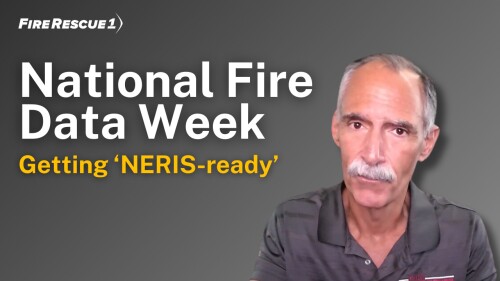Welcome to summer, home of beach days, ice cream, vacation and … fire data week?
Yes, this week is National Fire Data Week. Created by the U.S. Fire Administration (USFA) as a way to focus the attention of the fire service on the importance of data-driven decision-making, the theme of this year event is all things NERIS, the new national fire data standard. The National Emergency Response Information System (NERIS) is slated for launch later this year and promises to change the way the fire service reports its information. I urge you to follow the USFA social media channels, as everything they share this week will be centered on NERIS and what’s to come. But while NERIS is important, it is just one piece of your department’s fire data challenge and opportunity.
Building your data sandcastle
Today the fire service is surrounded by data but lacks information. Keeping with the summer theme, fire service data is like the grains of sand we walk through on the beach. There’s a lot of them, they get stuck in places we don’t want them to, and by themselves, they aren’t very useful, but mixed with water, they can be arranged into a castle. They can also get washed out to sea and never seen again. Let me explain.
We have access to more data than ever before. Most firefighters carry a small computer (smartphone) in their pocket; our tools, equipment, radios and apparatus create data points by the hundreds every time we turn them on; and the internet continues to provide us free and open access to hundreds of public data sets. But what does it all mean? Data by itself is often useless or, at least, less useful than it can be. It is, literally, the pile of sand on the beach you walk on. Individual granules of sand aren’t very useful on their own, but put thousands together, and you might have a beach.
So, what are the fire service data granules? For most departments, what we do (responses), where we go (address, building occupancy and use), who responds (personnel) and what we do when we get there (actions taken to resolve the incident) comprise the useful pieces we need to create meaningful information. Many fire departments use records management system (RMS) software to collect and store that data. Those RMS vendors should serve as your partner during your NERIS onboarding. You should, today, reach out to your vendor and ask what they are doing to get ready and what you’ll need to do as part of the transition. There will be some effort needed on your part – you’ll need to collect some information and documentation to create your NERIS profile, and it’s likely your RMS vendor can help with all of that. If you don’t have or use an RMS, fear not. There will be a functional, free and basic data collection tool available from the USFA to import your call data into NERIS.
Back to our beach analogy. How does data (like sand) get stuck in places you don’t want it? While not an exact comparison, consider how often we struggle to get two different software packages to speak to each other. How often do we need to download a file or photo and it gets “stuck” in the transmission process? How often is a file or folder difficult to find … or found but in a place don’t have access/permission to retrieve? I’m guessing more often than you’d like.
A lot of those issues can be solved with solid data governance. Data governance is everything you do to ensure that data is secure, private, accurate, available and usable. It includes the actions people must take to access the data, the processes they must follow, and the technology that supports them throughout the data life cycle. In short, it sets rules, expectations and creates the parameters for data to move inside your organization and from your organization to others. You should have good data governance and policy for your member data, information from your dispatch center, EMS call data/electronic patient care reports, and even how you answer a request for records that comes through a Freedom of Information Act request.
So, what do I need to do to build my data sandcastle? Since most data is stored electronically, we won’t be using water to combine data sets in ways that allow us to visualize data, turn data into information, or improve the usefulness of data. Combining data sets or connecting different systems together is a lot more difficult than it should be (a discussion for another day). But if there is a common element, such as an address, a call type or a date or time, you can start using data points to understand how they fit together. Absent that, we’re just mashing stuff together in hopes of it looking like a solid sandcastle. My word of caution is this: If you have a vendor, person or entity creating reports, dashboards or presentation for you using agency data, ask them about their methods and processes to do so. Ensure it is logical, reliable and accurate.
One additional note: You may have encountered artificial sand in your travels. It might have been at a mini-golf course, on a cruise ship or an indoor display. It looks like sand, it might feel like sand, but it is not sand. The same is occurring today in the data world with artificial intelligence (AI), a rapidly growing disruptive technology forging change in many areas. With that in mind, consider the following guidance: We are being assailed with promises of “new and improved” and “now with AI” fire service technologies. As you evaluate these products, ask what, exactly, is the AI component? How is the AI impacting the outcome? Who built the AI and how was it “trained” to do its work? (Note: AI and generative technologies like ChatGPT are trained using massive data sets to do their work. That data needs to be accurate or the result will be unreliable.)
On the horizon
We shouldn’t need a specific week of the year to focus on fire service data. It is an all -the-time issue to which the fire service must give its time and attention. Be aware of the coming changes as NFIRS goes away and we move to NERIS (remember to follow USFA social channels for more detail); use your local data to help make the important local decisions to improve your department; and work to ensure that the information you put into your reports (whether it be an RMS or some other method) is accurate and a true reflection of your department. As you take these steps, your department will be better prepared to provide service to your community, and that will make your summer ice cream, vacation or beach time that much better.




